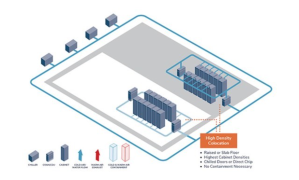

By Eric Swartz, vice president of data center engineering
Does your data center give you the flexibility to deploy a standard server cluster and then scale to a higher-density solution when required?
That’s what you will need if you’re planning any digital transformation projects focused on improving experiences for customers, internal users, and partners to stay ahead of competitors. A key factor in driving innovative digital transformation is High-Performance Computing (HPC), which has revolutionized the speed at which enterprises process data.
At the same time, HPC applications significantly impact IT infrastructures. The compute resource firepower—which needs to scale quickly—requires racks of high-density compute resources. This adds to the demand for more power along with greater cooling to make sure the racks don’t overheat.
Solving the infrastructure challenge is key because HPC is vital for just about every industry—from finance to healthcare, manufacturing, and research. The ability to crunch massive datasets, perform complex simulations, and accelerate time-to-insight makes HPC indispensable for meeting the needs of end-users and gaining competitive advantages.
The reliance on HPC by all these industries brings a host of challenges for data center providers in meeting the infrastructure requirements of their customers. As workloads grow more complex and datasets expand exponentially, data centers must deliver greater processing power with high-speed processors along with high-bandwidth networking technologies.
Another factor driving the need for HPC is the exploding demand for artificial intelligence (AI). This includes machine learning applications that use algorithms requiring vast computational resources to train models on massive datasets. AI thus further drives the need for scalable and efficient infrastructure solutions.
A third challenge reshaping the HPC landscape is the move toward cloud architectures and hybrid environments that blend on-premises and cloud infrastructures. While traditional on-premises HPC clusters remain popular for certain applications, many enterprises embrace the flexibility and scalability of the cloud. This means cloud providers must invest heavily in the HPC capabilities of their data centers by offering specialized instances, high-speed networking, and storage tailored to the unique requirements of HPC workloads.
At DataBank, we view the challenges HPC presents for data center providers as an opportunity to help our customers fuel their innovation initiatives. HPC requires us to tailor our offerings to support diverse deployment models for our customers and integrate our data centers seamlessly with cloud platforms. That’s exactly what we’ve done,. In doing so, we have opened avenues for greater collaboration.
By deploying our vast resources, we deliver cutting-edge solutions that give our customers the flexibility to move from a traditional environment to one that accommodates applications requiring greater density. One of the ways we do this is with our Universal Data Hall Design (UDHD), which allows us to accommodate any type of workload our customers need today — and in the future — including innovative HPC applications requiring ultra high–density.
Our vision for UDHD developed as we saw the demand for delivering solutions with very different requirements within the same data center. One of which is power to the rack, evolving from 120/208 volts to 240/415 volts.
In the past, customers needed multiple power circuits to achieve 20+ kilowatts in a single rack. However, with 240/415 volts, they can achieve 30+ kilowatts with a single power circuit. This lowers installation costs and consumes less rack space for the same amount of power allowing the compute to be physically closer together maximizing cluster speeds.
The DataBank Universal Data Hall Design

Accommodating HPC environments with a water-cooled design is made possible with either liquid cooling underneath a raised floor or overhead on a slab.
In addition, UDHD provides greater cooling capabilities—a key feature because HPC workloads typically generate more heat than traditional air systems can cool to sufficient temperatures. We have the flexibility to approach this issue in different ways based on the application’s need. We can deploy rear-door heat exchangers for high–density air applications, direct liquid to the chip for those that go beyond the capabilities of air, or even immersion for the most demanding needs. We support all these methods using a closed-loop air-cooled system that doesn’t waste water and is more environmentally friendly compared to other evaporative systems.
One example of a successful HPC deployment is the flagship computing cluster deployed by the research division at the University of Maryland (UMD). We helped the university deploy a cluster in one of our Northern Virginia DataBank data centers that makes compute resources available to any researcher on campus, spanning the fields of astronomy, physics, biology, social sciences, and artificial intelligence.
The solution required a custom 415V power distribution system and a mixture of traditional air cooling and high-density, direct liquid-to-the-chip cooling in the same environment. Our flexible design approach allowed UMD to deploy with no compromise to their design, enabling maximum performance.
Another example is DataBank’s collaboration with Georgia Tech in one of our Atlanta data centers. The university had unique requirements in that their HPC cluster runs upwards of 60 kW per rack using only air-cooled servers. We solved this by designing a portion of the data center to use rear–door heat exchangers for primary cooling.
We also deployed a dedicated cooling loop for the doors, and by moving the heat absorption to the back of each cabinet, we can cool the high–density racks while keeping the room temperature neutral. By having the doors on a separate loop, we support the university’s other needs for more traditional density racks—using standard perimeter air cooling running at different temperatures.
With the rapid evolution of HPC reshaping the technology landscape and driving significant changes in infrastructure demands, enterprises must stay ahead of these trends and adapt their offerings to remain competitive. By embracing innovations in hardware, power, and cooling, and by leveraging hybrid and cloud-based architectures, DataBank helps customers navigate the complexities of the HPC landscape to unlock new opportunities for growth and innovation.
Lead the HPC revolution with us – connect with our experts today.
See these related resources:
Colocation for High-Performance Computing (HPC) DataBank’s Universal Data Hall Design
Five Advantages of Colocation for High Performance Computing
University of Maryland Helps Solve Global Challenges Through Analysis Powered by High-Performance Computing. << University of Maryland Helps Solve Global Challenges Through Analysis Powered by High-Performance Computing – DataBank | Data Center Evolved Enhancing Research Capabilities through DataBank’s HPC Solution >>

Discover the DataBank Difference today:
Hybrid infrastructure solutions with boundless edge reach and a human touch.